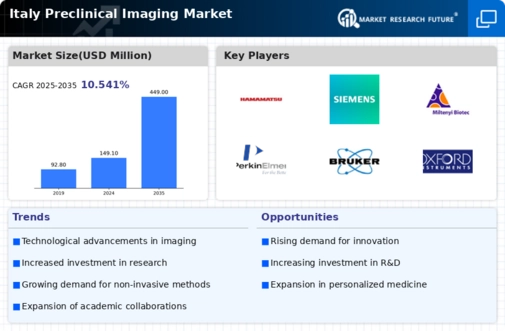The preclinical imaging market in Italy is characterized by a dynamic competitive landscape, driven by advancements in technology and increasing demand for innovative imaging solutions. Key players such as Bruker (DE), PerkinElmer (US), and Siemens Healthineers (DE) are at the forefront, each adopting distinct strategies to enhance their market presence. Bruker (DE) focuses on innovation, particularly in the development of high-resolution imaging systems, which positions it as a leader in the market. Meanwhile, PerkinElmer (US) emphasizes partnerships with research institutions to foster collaborative innovation, thereby expanding its product offerings and enhancing its competitive edge. Siemens Healthineers (DE) is actively pursuing digital transformation initiatives, integrating AI and machine learning into its imaging solutions, which not only improves efficiency but also enhances diagnostic capabilities. Collectively, these strategies contribute to a competitive environment that is increasingly centered around technological advancement and collaborative efforts.
In terms of business tactics, companies are localizing manufacturing and optimizing supply chains to enhance operational efficiency. The market appears moderately fragmented, with several key players exerting influence over various segments. This fragmentation allows for a diverse range of products and services, catering to the specific needs of research institutions and pharmaceutical companies. The collective influence of these players shapes the market structure, fostering an environment where innovation and strategic partnerships are paramount.
In October 2025, Siemens Healthineers (DE) announced a strategic partnership with a leading Italian university to develop advanced imaging techniques for preclinical research. This collaboration is expected to leverage the university's research capabilities alongside Siemens' technological expertise, potentially leading to groundbreaking advancements in imaging modalities. Such partnerships not only enhance Siemens' product portfolio but also solidify its position as a thought leader in the preclinical imaging space.
In September 2025, PerkinElmer (US) launched a new imaging platform designed specifically for small animal studies, which integrates advanced analytics and imaging capabilities. This launch is significant as it addresses the growing demand for precise and efficient imaging solutions in preclinical research. By focusing on this niche, PerkinElmer is likely to capture a larger share of the market, appealing to researchers seeking cutting-edge technology.
In August 2025, Bruker (DE) unveiled a novel imaging system that combines multiple imaging modalities into a single platform. This innovation is particularly noteworthy as it enhances the versatility and efficiency of preclinical studies, allowing researchers to obtain comprehensive data from a single imaging session. The introduction of such a system may redefine operational standards in the market, pushing competitors to innovate further.
As of November 2025, current trends in the preclinical imaging market include a strong emphasis on digitalization, sustainability, and the integration of AI technologies. Strategic alliances are increasingly shaping the competitive landscape, enabling companies to pool resources and expertise to drive innovation. Looking ahead, it appears that competitive differentiation will evolve from traditional price-based competition to a focus on technological innovation, reliability in supply chains, and the ability to deliver tailored solutions. This shift suggests that companies that prioritize R&D and strategic collaborations will likely emerge as leaders in the evolving market.






















Leave a Comment